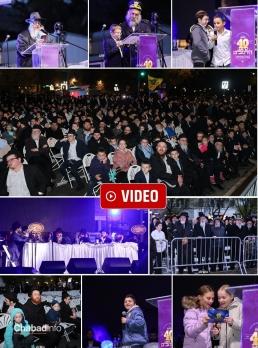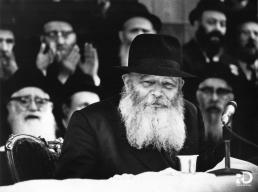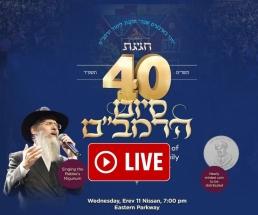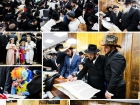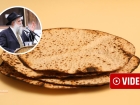Rabbi Shmuel Butman: The Rebbe Farbrenged At Our Home In Paris
What brings Rabbi Shmuel Butman, director of Lubavitch Your Organization — a demanding job by all means, to put on the historian hat and after a long journey of research, publish a book documenting the Rebbe and Rebbetzin’s years in France’s capital? • In this exclusive interview, Rabbi Butman speaks of his personal connection to this captivating historical period, and shares with us behind-the-scenes information and revelations he encountered in the process of publishing the book • Full Article
By Avrohom Rainitz, Beis Moshiach Magazine
To the Butman family, the phrase “the Rebbe in Paris” brings back a wealth of memories from the Rebbe’s second visit to Paris in 1947. The Butman family at the time lived in a house where Rebbetzin Chana a’h was also being hosted, and that is how they met the Rebbe many times.
Although Rabbi Shmuel Menachem Mendel Butman was a child at the time, he “lives” the memories thanks to his parents and older brother who told him again and again about those days, in detail, until the stories became etched in his memory.
After the Rebbe returned to the United States with his mother, the Butman family continued to relive that special time. They called the third room in their home, where Rebbetzin Chana stayed, “Rebbetzin Chana’s room.”
THE REBBE VISITED OUR HOME TWICE A DAY
How did you form a connection with Rebbetzin Chana?
The Rebbe came to Paris in 5707 in order to escort his mother to the United States. The Rebbe came on a flight from New York and landed in Paris on Tuesday, 26 Adar.
We arrived in Paris a few days later, on Sunday, 2 Nissan. My maternal uncle, Rabbi Zalman Schneerson, who had a three-story building on 10 Rue Dieu went to New York two weeks earlier and left us a three-room apartment on the third floor.
When we arrived, we found out that Rebbetzin Chana was a guest in the same building, on the second floor, but she did not have a private room. My parents immediately told the Rebbetzin that she could move to our apartment to a room with two doors, one door that led to the hall outside the apartment, and another door from where you entered the dining room. The Rebbetzin thus received full privacy while being able to join us for meals, etc.
Further down the hall was a small shul that my uncle set up for the refugees. Rebbetzin Chana went to shul often and on Shabbos the Rebbe would also come to daven in this shul.
Throughout this time, the Rebbe stayed in a hotel in the center of the city which was a twenty-minute walk from our house. The Rebbe came twice a day to visit his mother at set times, at 1:30 in the afternoon and 6:30 in the evening. The Rebbe sat with the Rebbetzin and my mother served the Rebbe a cup of tea with sugar and mezonos on the side. My mother would relate that when he ate the mezonos, the Rebbe did not use the sugar, saying, “There is sugar in the mezonos.”
On Fridays, the Rebbe would come to see his mother and leave his tallis in her room which was in a white bag. He davened Kabbolas Shabbos in the shul on the third floor and after davening had the Shabbos meal with his mother and us. We had the privilege of having the Rebbe eat the Shabbos meals in our home throughout that time. Sometimes, other Chassidim would join the Shabbos meal.
After the meal, the Rebbe returned to his hotel and in the morning he came back to the shul on the third floor. According to what I heard, nearly every week the Rebbe was honored with the third aliya or maftir and the Rebbe gave 300 francs for the aliya. Sometimes, the Rebbe asked to say a few words.
The Rebbe himself davened b’yechidus. When the others in shul reached chazoras ha’shatz, my brother would inform the Rebbe and then the Rebbe took his tallis bag and went to shul. During the Torah reading the Rebbe stood next to the chazan’s lectern leaning his right hand on the lectern on which there was a Chumash. He faced the reading table. The Rebbe stayed in shul until the end of the davening and only then began to daven at length.
The Rebbe sometimes spoke at the third meal. I heard from my brother that when they said chapter two of Pirkei Avos, the Rebbe asked why it says “Rebbi omer” (Rebbi says) and not “Omar Rebbi” (said Rebbi) when nobody disagrees with him and from the wording “Rebbi omer” it seems that others think otherwise.
The Rebbe said that indeed, there are those who argue against the Rebbe and who are they? The entire world. And the Rebbe opposes the entire world and says that the straight path is not the path that the world wants, but the path of Torah and mitzvos.
My father told me that during the visit, the Rebbe spoke a few times in the shul on the third floor. The Rebbe asked what they were learning and after they said which Gemara they were learning, the Rebbe began saying a long sicha on the topic, combining Nigleh and Chassidus. Then he asked: What else are you learning? When they said they were learning Shulchan Aruch, such-and-such a se’if, the Rebbe began a long sicha on that se’if. When he finished, the people said they were learning Tanya and the Rebbe gave an entire explanation on the Tanya they were learning. Finally, amazingly, the Rebbe connected all three subjects!



Rabbi Shneur Zalman Butman
THE REBBE REVEALED HIS BIRTH DATE
When was the first time you met the Rebbe?
The day we arrived, 2 Nissan, the Rebbe came to visit his mother and he saw my father, R’ Shneur Zalman, from the distance. The Rebbe approached him with a luminous countenance and said with a smile, “It seems this is R’ Zalman Butman.” My father responded in kind, “It seems this is the Rebbe’s son-in-law.” The Rebbe liked this and said, “Regards for you from a telegram that you sent to my father-in-law from the DP camp.”
In those days, when they spoke about the Rebbe, they called him “Ramash,” but when when they spoke to him directly, they called him, “Rabbi Schneerson.” In their first encounter, my father said to the Rebbe, “Rabbi Schneerson, yesterday was my birthday. May I receive your blessing?”
The Rebbe asked, “What year were you born?”
When my father said he was born in 5663, the Rebbe said, “You are from 5663 and I am from 5662.”
The Rebbe said, “Your birthday is on Rosh Chodesh Nissan? My birthday is also in Nissan.”
In those days, Chassidim did not know when the Rebbe’s birthday was and since the Rebbe began to talk about it, my father felt it was an opportunity to cautiously say, “May I ask when?”
“Yud-Alef,” said the Rebbe. “And for eleven days of the year, we say the same chapter [of Tehillim].”
THE FIRST 11 NISSAN FARBRENGEN
They say that the Rebbe also farbrenged in your house that 11 Nissan.
Yes. As 11 Nissan approached, my father told a group of Lubavitcher Chassidim in Paris about the Rebbe’s birthday and some of them decided to come to our house at the time the Rebbe usually came to visit his mother, in the hopes that they would get to hear something from him.
[Parenthetically, one of the people who was there was R’ Nachum Yakobovitz, a Hungarian Jew who became mekushar to the Rebbe to an exceptional degree from whom I heard a lot about the events of those days. He told me that that year he was twenty, and during that time the Rebbe farbrenged twenty times and he participated in every one of those farbrengens. Whenever he told this to me, he would cry.]
When Rebbetzin Chana saw the men who came she said to one of them: You need to ask my son to farbreng. Today is his birthday.
When they conveyed the request to the Rebbe, he immediately sat down at the table and began to farbreng with them.
The Rebbe asked: The first time a birthday is mentioned in Torah is with Pharaoh’s birthday from which it seems that this is something that pertains to Pharaoh, so why do we mark the day?



The Rebbe farbrenging in Paris in 1947
The Rebbe explained at length, based on a principle brought in drushei Chassidus, that the Pharaoh that we know from the simple reading of the text is a Pharaoh who belongs to kelipa, but there is also a Pharaoh of kedusha, and there too, there is the idea of a birthday, and this is the source of the idea in kedusha.
As is well known, this was the first time that the Rebbe farbrenged with Chassidim on his birthday and we had the privilege of it being in our house.
The Rebbe had the Sedarim on Pesach as well as the other Pesach meals in our house. We had the Sedarim on the second floor where there was a large hall with a big table. The Rebbe sat at the head of the table with his mother on his right and the ladies next to her. Next to the Rebbe sat the men who sat about half a seat space distant from the Rebbe. Every so often the Rebbe explained something in the Haggada and all sat quietly and listened. By the way, there was a red thread tied to the Rebbe’s fork and spoon so they wouldn’t be mixed in with the other utensils.
THE REBBE RAISED US ABOVE THE MUNDANE REALITY
After the Rebbe arranged all his mother’s documents, he traveled with her to New York by ship. Although he flew to Paris, he returned by ship since in those days traveling by plane was difficult for older people. I heard that this was an instruction from the Rebbe Rayatz.
The Rebbe left Paris on 22 Sivan and arrived in New York on Monday, 28 Sivan. Interestingly, the date 28 Sivan is the day the Rebbe arrived both times in America, in 5701 and 5707. Before he left Paris, Sunday night, Anash held a “tzeischem l’shalom” for him. This took place on the second floor in the large hall where even weddings took place.
The gathering began at eight at night with important rabbanim and askanim in attendance who spoke. At ten o’clock, only Anash Chassidei Chabad remained and the Rebbe banged on the table and said: Now we will start a Chassidishe farbrengen.
This was another sort of farbrengen which the participants all remembered for the rest of their lives. The Rebbe asked each one of them to say l’chaim and then to say their name and their father’s name. Then the Rebbe began to explain the character of that Chassid based on the names, from the Torah-Neviim-Kesuvim, according to Nigleh, Chassidus, Kabbala and Chakira, and the crowd went wild.
My father told me that between sichos he sat next to the Rebbe and he told the Rebbe that he once spoke with the Rebbe’s father and R’ Levi Yitzchok said about his son that “he does better than me.” When the Rebbe tried to minimize the significance of this by saying, “That’s what a father ought to say…” my father responded in kind, “That’s also what a son ought to say.”
R’ Nachum Yakobovitz who told me about this farbrengen, said that the Rebbe lifted those present a hands-breadth above the mundane reality. The Rebbe sat all night and toward morning some children came and the Rebbe danced with them. At the end of the farbrengen, the Rebbe did not want his mother to be told that he was up all night so she shouldn’t worry.
PERSONAL GIFTS FOR EVERYONE
Before leaving Paris, the Rebbe gave a personal gift to each member of our family. He gave my father a Torah Ohr siddur and a picture of the Rebbe Rayatz and the Rebbe playing chess. On that occasion, the Rebbe told him that they were not playing on Nittel Nacht but when the Rebbe Rayatz was staying in a resort town for his health. The Rebbe also said that at first he played so that the Rebbe Rayatz would win but the Rebbe Rayatz noticed this and said: You need to play ehrlich.
The Rebbe gave my brother, R’ Sholom Ber a volume of Sefer Maamarim – Yiddish. My sister Leah, later wife of Rabbi Yoel Kahn, who had told the Rebbe that she collects stamps, had the Rebbe occasionally give her stamps from the letters he received and before he left he brought her a stamp album which she has till this day. My younger sister Miryam (Swerdlov) received a special top.
I also received a present, a bike with brakes and training wheels. That bike was a big attraction for all the kids who came to our house and asked to ride it.
For my mother and my aunt, Rebbetzin Sarah Schneerson, the Rebbe brought a special gift: a large, special set of dishes. In those days, who had a set like that? When we left Paris in 5714, my mother left the set with her brother, R’ Zalman (who returned to Paris in 5713) although half belonged to her. My aunt and uncle gave us some dishes that we have and we use them on special occasions like erev Yom Kippur.
MEMORIES FROM THE FIRST PERIOD IN PARIS
We spoke a lot so far about the Rebbe’s second visit to Paris, when you spent time with him every day, but most of your book, HaRebbe b’Paris is about the first period, when he lived with the Rebbetzin in Paris for eight years. Tell us a story that you heard about this period.
When the Rebbe lived in Paris, he tried to hide his greatness but some were able to discern it and they asked the Rebbe to give shiurim in shuls. Jews in Paris were able to attend shiurim by the Rebbe in two shuls where he davened, both on Rue Des Rosiers. Some stories have circulated about these shiurim and since I heard that one of the participants was R’ Dovid Shmaya Reichman, the father of the well-known wealthy Reichmans, I once took the opportunity when I met his son, R’ Eliyahu, to ask him to tell me what he heard from his father. This is what he told me with great warmth and admiration:
In those years, when there was a Gemara shiur in the 25 Rue Des Roseiers shul there weren’t enough sefarim for all the participants and so every two to three people would share one Gemara. The Rebbe gave the shiur from his own Gemara, of course. When the Rebbe taught Gemara he said the words of the Gemara, Rashi and Tosafos and explained with additions of his own.
One day, in a shiur on the tractate Shabbos, my father noticed that the wording of Rashi as the Rebbe read it was different than the wording in his own Gemara. He assumed the Rebbe’s Gemara was a different edition and decided to check the different versions after the shiur.
When the Rebbe finished giving the shiur, he opened the sefer that the Rebbe used and was astounded to discover that the Rebbe had been using a Gemara Chullin! Because of the lack of sefarim, no Gemara remained for the Rebbe and since the Rebbe didn’t want people to realize the extent of his proficiency he opened a different Gemara and seemed to read from it!
ALL THE COPIES OF THE “TESHURA” WERE GRABBED UP
As the director of several Chabad mosdos and organizations in New York, you probably don’t have time to write sefarim. What made you write this book anyway?
Divine providence led to my writing it. When our daughter Hadassah Esther married R’ Yehuda Leib Heber, my mechutan, R’ Shmuel Heber, asked me to take part in putting out a teshura for the wedding as has become customary.
I wondered what to put into the teshura. Over the years, I had received many answers from the Rebbe on many subjects but I thought that for a wedding teshura it would be nicer to have something more story-like, that people could read and enjoy. Then I thought of writing about the Rebbe’s visit to Paris in 5707. Over the years, memories of that time were published here and there but nothing like a full collection on the topic. Since my family was very involved, I felt it was fitting for a family teshura. I sat at the computer and was able to write forty pages with memories of the visit of 5707.
When the booklets were brought to the wedding at Oholei Torah, one of the bachurim ran to the zal and told everyone about the teshura. Within minutes, no copies of the teshura were left. The next day I got a phone call from Rabbi Leibel Groner, the Rebbe’s secretary, thanking me for the teshura. He said it was the nicest teshura he had ever seen.
Considering the enthusiastic feedback I got from Anash after the wedding and the fact that many wanted the teshura, I sat down again at the computer to add some more memories and to reprint the teshura. As I did this, I did research on the first period when the Rebbe was in Paris for eight years. That period is considered a hidden one in the Rebbe’s history but in recent years numerous documents and memories were published which allows us to construct a complete, fascinating mosaic with many giluyim and new insights.
THE SHLICHUS TO PARIS – LIKE THE SHLICHUS TO CHARAN
What do you think is the main reveal of the book?
With a book like this, which contains thousands of fascinating facts, it’s hard to point at one detail and say this is the main reveal. On the other hand, there is an interesting and important key insight that became clear to me after I collected all the material about the period when the Rebbe lived in Paris.
For many years, people from outside Chabad thought that the Rebbe lived in Paris so he could attend the Sorbonne. In Chabad publications too, they did not know about this period and they wrote only that the Rebbe learned Torah and studied academic subjects at a local university, by instruction of his father-in-law, the Rebbe Rayatz. Likewise, he participated in the Rebbe Rayatz’s communal work and served as his secretary.
After reading the hundreds of pages of the book, which details much of the holy work that the Rebbe carried out in Paris on shlichus of his father-in-law, one suddenly realizes that the academic studies were peripheral to the Rebbe’s life in Paris. Most of his time was devoted to the Rebbe Rayatz’s work.
The Rebbe himself called that period a “shlichus.” In the sicha of Vayeishev 5752, when the Rebbe spoke about the Jewish revolution in France, which symbolizes the preparation of the world to greet Moshiach, the Rebbe said that the Rebbe Rayatz sent shluchim from his household there, who were there for some years, and did their avoda in studying Nigleh and pnimiyus ha’Torah, and he sent some of his Chassidic writings and letters there, and some things were prepared for print there… in addition to quite a few divrei Torah which were written there (and afterward) printed.
In a few lines, the Rebbe explains to us in a wondrous, succinct way, the reason for his trip and his living and activities in Paris. First of all, the Rebbe defines it all as a shlichus. The Rebbe and Rebbetzin didn’t just happen to go to France. They didn’t live there; they were shluchim of the Rebbe Rayatz.
In connection with this point it’s interesting to note that the first shlichus mentioned in Torah with the word “shlichus” is when Yitzchok sent Yaakov to Charan, as it says, “and Yitzchok sent Yaakov.” This shlichus of the Rebbe was also one in which Yitzchok (the Rebbe Rayatz) sent Yaakov (his son, a son-in-law like a son) to Charan (the “charon af” of a place in the world, a low place like France, which the Rebbe called, “the lowest place” and “the intensity of kelipa”).
Every word in the Rebbe’s succinct summary is elaborated on in the book. In documents that came to light in recent years, some of them, by the way, in Beis Moshiach, we find that the Rebbe edited HaTamim in Paris (as the Rebbe Rayatz writes to his daughter that the editors listed on paper will be others, “but the work is his”) and other projects of editing drushei Chassidus which are described at length in the book.
WAITING TO SAY CHAPTER 119
Did you hear additional stories about that period after you printed the book?
Yes. G-d willing, the next edition will have more stories. I’ll share one that wasn’t in the book which has a lesson for us.
One Shabbos, when the Rebbe farbrenged with Chassidim in shul, one of the Chassidim said something which shouldn’t have been said. He said, soon it will be 12 Tammuz, the Rebbe Rayatz’s birthday, and we will have to say a long chapter of Tehillim (68).
The Rebbe did not look pleased. My father noticed this and quickly said: We are waiting for the Rebbe to be 118 already so we can joyfully say chapter 119 every day!
After my father said that, the Rebbe looked very pleased.
THE SECRET OF PARIS: PREPARING FOR MOSHIACH’S COMING
In the introduction to the second edition of the book, you wrote a section under the title, “The Secret of Paris.” What was the secret?
As I mentioned before, from the trove of documents and fascinating memories in the book one sees that the Rebbe had a special mission in France and most of his time was devoted to that. But, after all, the
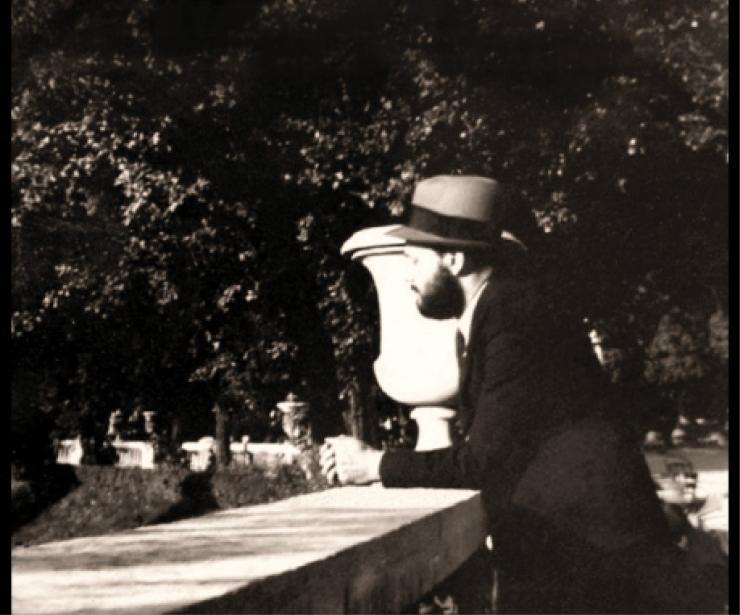


The Rebbe on his first visit to Paris
question remains, why the Rebbe? And why Paris? Many of the things that the Rebbe did he could have done while living near the Rebbe Rayatz, and some of the activities could have been done by other Chassidim.
The answer to all this I found in the sicha of the Rebbe from parshas Vayeishev 5752. I think that in these words the Rebbe reveals to us the secret and answer to those questions. This is what the Rebbe says:
“In order to bring about the birur of the lowest place, one needs the power of etzem… specifically in the lowest place is where the etzem is revealed which brings about the birur of the entire world.”
Simply put, the Rebbe Rayatz wanted to prepare the world for the Geula and there is the mashal in Chassidus that in order to raise a building, it needs to be raised from the bottom. Therefore, preparing the world to welcome Moshiach had to begin in Paris.
In the sicha, the Rebbe adds another amazing point which explains why he was the one who had to be sent on this shlichus. To ensure the birur of the lowest place it’s impossible to send ordinary people. One has to send someone whose power of etzem shines within; it is with this power that one refines the world and prepares it for Moshiach.
In the Rebbe’s sichos of the winter 5752, he spoke a lot about the revelation of etzem with the complete Geula and explained that etzem comes to the fore before the revelation. For example the Rebbe says that as soon as someone wakes up, even before starting to say “Modeh Ani,” his etzem existence as a Jew is already revealed.
The same is so with the Rebbe. After the Rebbe accepted the nesius we had many giluyim from the Rebbe but before the nesius, when there weren’t yet giluyim, was the time he operated on an “etzem” level and through that succeeded in making a spiritual revolution in France.
By the way, many Chassidim who remembered the Rebbe from Paris, stressed in their memoirs that it was apparent that this was a Jew who was an “atzmi” who was not dependent on and influenced by his surroundings at all. Yes giluyim, no giluyim, Lubavitch, Paris – nothing effects a change in his avodas ha’kodesh!
Thus, the Rebbe, who is “atzmi,” was able to uplift Paris and all of France, and through that, the entire world. As the Rebbetzin said: We plowed and sowed, and you need to reap! Now the time has come to reap the true and complete Geula with the hisgalus of the Rebbe Melech HaMoshiach, teikef u’miyad mamosh!
*
The magazine can be obtained in stores around Crown Heights. To purchase a subscription, please go to: bmoshiach.org
187
Join ChabadInfo's News Roundup and alerts for the HOTTEST Chabad news and updates!


















